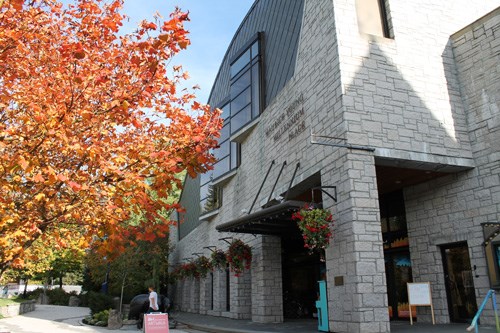The news that B.C. was lifting its COVID-19 restriction limiting capacity for indoor, organized events came as a welcome surprise for Arts Whistler executive director Mo Douglas.
“It was definitely good news,” she says. “But the province has taken quite a cautious approach, so we kind of thought we’d be at that 50-per-cent [capacity] for a little longer.”
After more than a year and a half without any ticketed indoor shows, the local organization finally re-opened the 200-seat Maury Young Arts Centre theatre doors to the public for a pair of ski and snowboard film screenings earlier this month. With only 100 tickets available, both events sold out in short order.
As people clamour to return to events, a return to full capacity “is going to make life easier for all of us,” says Douglas.
“It’s exciting to be sold out, but being sold out [at] 100 seats is not that hard to do, and it actually results in a fair amount of disappointment for the other 100 people who couldn’t get in. So it’s great that we now have 200 seats.”
The caveat? All 200 of those guests will now have to show proof they’ve received two doses of a COVID-19 vaccine. The capacity limit was lifted on Monday, Oct. 25, the same day a requirement mandating British Columbians aged 12 and older be double-immunized in order to access the list of non-essential, indoor activities included in B.C.’s COVID-19 vaccine card program went into effect. The rule change affects events like weddings, ticketed sports games, movie theatres and concerts, including the kinds of events that take place in Whistler’s Maury Young Arts Centre.
Guests are still required to wear masks in indoor public places, so long as they’re not eating and drinking, while dancing in nightclubs and other indoor venues remains off-limits. (Restrictions limiting venues’ capacity to 50 per cent remain in parts of the Fraser, Northern and Interior health regions, where vaccination rates are below the provincial average.)
Even with half capacity, Douglas says the recent screenings functioned as a successful test run for staff in terms of theatre operations and checking vaccine card protocols.
“We’re learning as we go, but these orders have not been particularly hard to execute,” she says.
With more film screenings scheduled for MYAC in November, Douglas says Arts Whistler will give producers the option of upping their contract to 200 seats and is looking ahead to welcoming a full house for its own productions in early December (a weekly comedy series and an artist reception for an upcoming art exhibit are on the docket). Full capacity also means more freedom for Arts Whistler in terms of revenue, Douglas adds.
“You can take a little bit more risk on your talent costs and everything else if you know you can actually sell a full theater,” she says. “That opens up more opportunity for us to do more and truly start working towards getting back to the new normal.”
Because even with streaming tools now available, “there just isn’t any replacement for being in a space with live entertainment.”
CORNUCOPIA STICKING WITH EXISTING ATTENDANCE CAPS
With Cornucopia now just days out from its own indoor, organized events, Watermark Communications president Sue Eckersley confirms the celebration of all things food and beverage, scheduled to kick off Nov. 4, is still standing by its decision to limit crowds in 2021.
The festival producer confirmed in September that Cornucopia would return this year with an expanded, month-long roster of events, but said attendance limits for most will be capped well below the provincial capacity restrictions. All guests and staff are also required to be double- vaccinated.
After considering the risks associated with COVID-19 and consulting public health guidance, Eckersley tells Pique in an email that organizers also took Dr. Bonnie Henry’s continued reminders about the importance of personal and corporate responsibility to heart.
“This resonates with us,” Eckersley writes. “I fully respect the change of orders to allow businesses to operate with more flexibility—that does not mean all businesses should take that opportunity. It means that we need to each access the risk to our guests and community and make choices that best serve the safety of each.”
That said, there is one remaining restriction yet to be lifted that Eckersley and crew will be keeping an eye on: “If dancing becomes allowed, we will create a modified environment that allows those who feel safe dancing, [to] dance,” she says, “and for those that aren’t ready for that they’ll have plenty of space as well.”




